Coxafen (Flucloxacillin)
Coxafen (Flucloxacillin)
Couldn't load pickup availability
Action
Flucloxacillin, also known as floxacillin is a narrow-spectrum beta-lactam antibiotic of the penicillin class. It is similar in effect to cloxacillin and dicloxacillin, being active against penicillinase forming bacteria. It works by breaking down the bacterial cell wall. Like other β-lactam antibiotics, flucloxacillin acts by inhibiting the synthesis of bacterial cell walls. It inhibits cross-linkage between the linear peptidoglycan polymer chains that make up a major component of the cell wall of Gram-positive bacteria. Flucloxacillin is more acid-stable than many other penicillins and can be given orally, in addition to parenteral routes. However, like methicillin, it is less potent than benzylpenicillin against non-β-lactamase-producing Gram-positive bacteria. Flucloxacillin has similar pharmacokinetics, antibacterial activity, and indications to dicloxacillin, and the two agents are considered interchangeable. It is reported to have higher, though rare, incidence of severe hepatic adverse effects than dicloxacillin, but a lower incidence of renal adverse effects. Despite flucloxacillin being insensitive to beta-lactamases, some organisms have developed resistance to it and other narrow-spectrum β-lactam antibiotics including methicillin. Such organisms include methicillin-resistant Staphylococcus aureus, which has developed resistance to flucloxacillin and other penicillins by having an altered penicillin-binding protein.
Indication
Flucloxacillin is used to treat skin infections, external ear infections, infections of leg ulcers, diabetic foot infections, and infection of bone. It may be used together with other medications to treat pneumonia, and endocarditis. It may also be used prior to surgery to prevent Staphylococcus infections. It is not effective against methicillin-resistant Staphylococcus aureus (MRSA). Flucloxacillin is used for both staphylococcal and streptococcal skin infections. These include folliculitis, carbuncles, impetigo, ecthyma, cellulitis, erysipelas, necrotising fasciitis, and infections of skin conditions such as eczema, scabies, ulcers and acne. Due to the widespread belief that dual-therapy is needed to cover both Staphylococcus and Streptococcus in cellulitis, flucloxacillin is sometimes given with the addition of benzylpenicillin for more severe cellulitis. However, support for this practice has lessened since findings in a study published in the Emergency Medicine Journal in 2005 did not show this combination to give additional clinical benefit.
Dose
It is taken by mouth, intramuscular, intravenous, intrapleural, intraarticular.
Contraindication
It should not be used in those who are allergic to penicillin.
Pregnancy & Lactation
It appears to be safe during pregnancy and breastfeeding.
Adverse Reaction
Common side effects include an upset stomach.[4] Other side effects may include muscle or joint pains, shortness of breath, and liver problems.
Content
Content
Share





